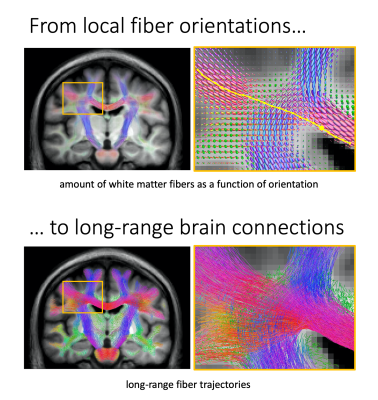Weekend Educational Session
Diffusion: Micro & Macro
| Sunday Parallel 1 Live Q&A | Sunday, 9 August 2020, 15:00 - 15:30 UTC | Moderators: Dmitry Novikov & Andrey Zhylka |
Session Number: WE-26
Overview
The course will cover the basics of diffusion MRI, provide overview of signal representations and microstructure models along both q- and time-dimensions, highlight validation methods such as diffusion-weighted spectroscopy, and give up-to-date outlook on fiber tractography and clinical applications of diffusion MRI.
Target Audience
Scientists and clinicians interested in interpreting and applying diffusion MRI to quantify both sub-voxel microstructure and macroscopic connectivity.
Educational Objectives
As a result of attending this course, participants should be able to:
- Define the basics of diffusion-weighted contrast;
- Distinguish between biophysical models and signal representations;
- Apply different models and representations on a q-t diagram;
- Recognize animal and spectroscopic validation methods;
- Name key pitfalls of different tractography algorithms; and
- Describe current clinical applications of dMRI.
| More Diffusion, Less Confusion!
Chantal Tax
How can diffusion MRI be sensitive to microstructure if we have mm-sized voxels, and can smaller voxels solve the crossing fibre problem? Why are the estimated parameter maps directly from the scanner different from my offline analysis? Is myelin the main cause of anisotropy? This educational discusses 8 common confusions in diffusion MRI.
|
||
| Going Deep Into q-Space
Ileana Jelescu
The overall diffusion weighting, also referred to as the b-value, is the resulting diffusion attenuation from two different contributions: the spatial dephasing q imparted by the diffusion gradient pulse and the time t given to molecules to diffuse before they are rephased. Here, we will focus on increasing the q-vector for a fixed diffusion time t. This is what is commonly implied by “increasing the b-value”. Going “deep into q-space” opens entirely new doors for tissue microstructure mapping and brain tractography. The former are covered in this lecture.
|
||
| Once Upon an (Echo) Time
Junzhong Xu
This lecture will cover the basics and recent progress of diffusion time- and echo time-dependent diffusion MRI. We will explore how diffusion time affects diffusion MRI experiments, review some practical approaches to extend the range of achievable diffusion times and provide examples of how varying diffusion times assist better characterizing biological tissue microstructure. Second, we will briefly explore how echo time affects diffusion MRI with the presence of multiple compartments and review how echo time-dependent diffusion MRI provides an additional dimension to disentangle signal contributions from different compartments.
|
||
 |
MRS: A Diffusion Cocktail
Clemence Ligneul
This course aims at introducing diffusion-weighted magnetic resonance spectroscopy (DW MRS) to people with a basic understanding of diffusion MRI. Hopefully, you will be able to seize whether DW MRS techniques can be useful for your research question, and to get an idea of its implementation, from acquisition to analysis.
|
|
 |
Tracking Off the Beaten Track
Ben Jeurissen
Fiber tracking is the only tool that can delineate specific fiber bundles within the brain in-vivo, enabling region-specific investigation of MRI parameters and helping neurosurgeons to plan delicate neurosurgery. Fiber tracking has also claimed a central role in the field of ‘connectomics’, the study of the complex network of connections within the brain. Despite these unique abilities and exciting applications, fiber tracking is not without controversy, in particular when it comes to its interpretation. In light of this controversy, this course will provide an overview of the concepts, technical considerations, algorithms, mistakes and challenges of fiber tracking. |
|
| Pathology For Modeling: A Blessing or a Curse?
Pratik Mukherjee
|

 Back to Program-at-a-Glance
Back to Program-at-a-Glance Watch the Video
Watch the Video Back to Top
Back to Top